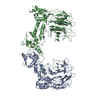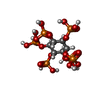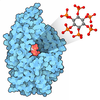[English] 日本語
 Yorodumi
Yorodumi- PDB-8voj: The Cryo-EM structure of LSD1-CoREST-HDAC1 in complex with KBTBD4... -
+ Open data
Open data
- Basic information
Basic information
| Entry | Database: PDB / ID: 8voj | ||||||
|---|---|---|---|---|---|---|---|
| Title | The Cryo-EM structure of LSD1-CoREST-HDAC1 in complex with KBTBD4 enhanced by UM171 and IP6 | ||||||
 Components Components |
| ||||||
 Keywords Keywords | TRANSCRIPTION / molecular glue / protein degradation / E3 ligase / transcription and translation | ||||||
| Function / homology |  Function and homology information Function and homology informationLoss of MECP2 binding ability to 5mC-DNA / Krueppel-associated box domain binding / Repression of WNT target genes / MECP2 regulates transcription of neuronal ligands / protein lysine delactylase activity / p75NTR negatively regulates cell cycle via SC1 / epidermal cell differentiation / positive regulation of megakaryocyte differentiation / histone decrotonylase activity / fungiform papilla formation ...Loss of MECP2 binding ability to 5mC-DNA / Krueppel-associated box domain binding / Repression of WNT target genes / MECP2 regulates transcription of neuronal ligands / protein lysine delactylase activity / p75NTR negatively regulates cell cycle via SC1 / epidermal cell differentiation / positive regulation of megakaryocyte differentiation / histone decrotonylase activity / fungiform papilla formation / NuRD complex / negative regulation of androgen receptor signaling pathway / regulation of cell fate specification / negative regulation of stem cell population maintenance / endoderm development / histone deacetylase activity, hydrolytic mechanism / Transcription of E2F targets under negative control by p107 (RBL1) and p130 (RBL2) in complex with HDAC1 / histone deacetylase / regulation of stem cell differentiation / protein deacetylation / Regulation of MITF-M-dependent genes involved in apoptosis / STAT3 nuclear events downstream of ALK signaling / Transcription of E2F targets under negative control by DREAM complex / DNA repair complex / protein lysine deacetylase activity / Hydrolases; Acting on carbon-nitrogen bonds, other than peptide bonds; In linear amides / embryonic digit morphogenesis / histone deacetylase activity / positive regulation of intracellular estrogen receptor signaling pathway / DNA methylation-dependent constitutive heterochromatin formation / Notch-HLH transcription pathway / negative regulation of gene expression, epigenetic / G1/S-Specific Transcription / Sin3-type complex / negative regulation of intrinsic apoptotic signaling pathway / eyelid development in camera-type eye / odontogenesis of dentin-containing tooth / positive regulation of stem cell population maintenance / E-box binding / histone methyltransferase complex / histone deacetylase complex / oligodendrocyte differentiation / RNA Polymerase I Transcription Initiation / positive regulation of oligodendrocyte differentiation / G0 and Early G1 / Regulation of MECP2 expression and activity / host-mediated suppression of viral transcription / hair follicle placode formation / NF-kappaB binding / FOXO-mediated transcription of oxidative stress, metabolic and neuronal genes / Regulation of MITF-M-dependent genes involved in cell cycle and proliferation / RNA polymerase II core promoter sequence-specific DNA binding / core promoter sequence-specific DNA binding / heterochromatin / Transcriptional regulation of brown and beige adipocyte differentiation by EBF2 / Nuclear events stimulated by ALK signaling in cancer / MECP2 regulates neuronal receptors and channels / Regulation of TP53 Activity through Acetylation / cellular response to platelet-derived growth factor stimulus / transcription repressor complex / negative regulation of canonical NF-kappaB signal transduction / positive regulation of smooth muscle cell proliferation / Transcriptional and post-translational regulation of MITF-M expression and activity / negative regulation of cell migration / SUMOylation of chromatin organization proteins / Regulation of PTEN gene transcription / erythrocyte differentiation / transcription corepressor binding / ERCC6 (CSB) and EHMT2 (G9a) positively regulate rRNA expression / Regulation of endogenous retroelements by KRAB-ZFP proteins / hippocampus development / Deactivation of the beta-catenin transactivating complex / HDACs deacetylate histones / Regulation of endogenous retroelements by Piwi-interacting RNAs (piRNAs) / promoter-specific chromatin binding / Downregulation of SMAD2/3:SMAD4 transcriptional activity / circadian regulation of gene expression / SMAD2/SMAD3:SMAD4 heterotrimer regulates transcription / negative regulation of transforming growth factor beta receptor signaling pathway / negative regulation of canonical Wnt signaling pathway / Formation of the beta-catenin:TCF transactivating complex / RUNX1 regulates genes involved in megakaryocyte differentiation and platelet function / NoRC negatively regulates rRNA expression / NOTCH1 Intracellular Domain Regulates Transcription / Constitutive Signaling by NOTCH1 PEST Domain Mutants / Constitutive Signaling by NOTCH1 HD+PEST Domain Mutants / histone deacetylase binding / neuron differentiation / p53 binding / transcription corepressor activity / heterochromatin formation / Factors involved in megakaryocyte development and platelet production / chromatin organization / transcription regulator complex / DNA-binding transcription factor binding / Estrogen-dependent gene expression / Potential therapeutics for SARS / RNA polymerase II-specific DNA-binding transcription factor binding / RNA polymerase II cis-regulatory region sequence-specific DNA binding / chromatin remodeling Similarity search - Function | ||||||
| Biological species |  Homo sapiens (human) Homo sapiens (human) | ||||||
| Method | ELECTRON MICROSCOPY / single particle reconstruction / cryo EM / Resolution: 3.77 Å | ||||||
 Authors Authors | Xie, X. / Mao, H. / Liau, B. / Zheng, N. | ||||||
| Funding support |  United States, 1items United States, 1items
| ||||||
 Citation Citation |  Journal: Nature / Year: 2025 Journal: Nature / Year: 2025Title: UM171 glues asymmetric CRL3-HDAC1/2 assembly to degrade CoREST corepressors. Authors: Megan J R Yeo / Olivia Zhang / Xiaowen Xie / Eunju Nam / N Connor Payne / Pallavi M Gosavi / Hui Si Kwok / Irtiza Iram / Ceejay Lee / Jiaming Li / Nicholas J Chen / Khanh Nguyen / Hanjie ...Authors: Megan J R Yeo / Olivia Zhang / Xiaowen Xie / Eunju Nam / N Connor Payne / Pallavi M Gosavi / Hui Si Kwok / Irtiza Iram / Ceejay Lee / Jiaming Li / Nicholas J Chen / Khanh Nguyen / Hanjie Jiang / Zhipeng A Wang / Kwangwoon Lee / Haibin Mao / Stefan A Harry / Idris A Barakat / Mariko Takahashi / Amanda L Waterbury / Marco Barone / Andrea Mattevi / Steven A Carr / Namrata D Udeshi / Liron Bar-Peled / Philip A Cole / Ralph Mazitschek / Brian B Liau / Ning Zheng /   Abstract: UM171 is a potent agonist of ex vivo human haematopoietic stem cell self-renewal. By co-opting KBTBD4, a substrate receptor of the CUL3-RING E3 ubiquitin ligase (CRL3) complex, UM171 promotes the ...UM171 is a potent agonist of ex vivo human haematopoietic stem cell self-renewal. By co-opting KBTBD4, a substrate receptor of the CUL3-RING E3 ubiquitin ligase (CRL3) complex, UM171 promotes the degradation of the LSD1-CoREST corepressor complex, thereby limiting haematopoietic stem cell attrition. However, the direct target and mechanism of action of UM171 remain unclear. Here we show that UM171 acts as a molecular glue to induce high-affinity interactions between KBTBD4 and HDAC1/2 to promote corepressor degradation. Through proteomics and chemical inhibitor studies, we identify the principal target of UM171 as HDAC1/2. Cryo-electron microscopy analysis of dimeric KBTBD4 bound to UM171 and the LSD1-HDAC1-CoREST complex identifies an asymmetric assembly in which a single UM171 molecule enables a pair of KELCH-repeat propeller domains to recruit the HDAC1 catalytic domain. One KBTBD4 propeller partially masks the rim of the HDAC1 active site, which is exploited by UM171 to extend the E3-neosubstrate interface. The other propeller cooperatively strengthens HDAC1 binding through a distinct interface. The overall CoREST-HDAC1/2-KBTBD4 interaction is further buttressed by the endogenous cofactor inositol hexakisphosphate, which acts as a second molecular glue. The functional relevance of the quaternary complex interaction surfaces is demonstrated by base editor scanning of KBTBD4 and HDAC1. By delineating the direct target of UM171 and its mechanism of action, we reveal how the cooperativity offered by a dimeric CRL3 E3 can be leveraged by a small molecule degrader. #1: Journal: Protein Sci / Year: 2018 Title: UCSF ChimeraX: Meeting modern challenges in visualization and analysis. Authors: Thomas D Goddard / Conrad C Huang / Elaine C Meng / Eric F Pettersen / Gregory S Couch / John H Morris / Thomas E Ferrin /  Abstract: UCSF ChimeraX is next-generation software for the visualization and analysis of molecular structures, density maps, 3D microscopy, and associated data. It addresses challenges in the size, scope, and ...UCSF ChimeraX is next-generation software for the visualization and analysis of molecular structures, density maps, 3D microscopy, and associated data. It addresses challenges in the size, scope, and disparate types of data attendant with cutting-edge experimental methods, while providing advanced options for high-quality rendering (interactive ambient occlusion, reliable molecular surface calculations, etc.) and professional approaches to software design and distribution. This article highlights some specific advances in the areas of visualization and usability, performance, and extensibility. ChimeraX is free for noncommercial use and is available from http://www.rbvi.ucsf.edu/chimerax/ for Windows, Mac, and Linux. | ||||||
| History |
|
- Structure visualization
Structure visualization
| Structure viewer | Molecule:  Molmil Molmil Jmol/JSmol Jmol/JSmol |
|---|
- Downloads & links
Downloads & links
- Download
Download
| PDBx/mmCIF format |  8voj.cif.gz 8voj.cif.gz | 285.4 KB | Display |  PDBx/mmCIF format PDBx/mmCIF format |
|---|---|---|---|---|
| PDB format |  pdb8voj.ent.gz pdb8voj.ent.gz | Display |  PDB format PDB format | |
| PDBx/mmJSON format |  8voj.json.gz 8voj.json.gz | Tree view |  PDBx/mmJSON format PDBx/mmJSON format | |
| Others |  Other downloads Other downloads |
-Validation report
| Summary document |  8voj_validation.pdf.gz 8voj_validation.pdf.gz | 1.6 MB | Display |  wwPDB validaton report wwPDB validaton report |
|---|---|---|---|---|
| Full document |  8voj_full_validation.pdf.gz 8voj_full_validation.pdf.gz | 1.6 MB | Display | |
| Data in XML |  8voj_validation.xml.gz 8voj_validation.xml.gz | 61 KB | Display | |
| Data in CIF |  8voj_validation.cif.gz 8voj_validation.cif.gz | 90.5 KB | Display | |
| Arichive directory |  https://data.pdbj.org/pub/pdb/validation_reports/vo/8voj https://data.pdbj.org/pub/pdb/validation_reports/vo/8voj ftp://data.pdbj.org/pub/pdb/validation_reports/vo/8voj ftp://data.pdbj.org/pub/pdb/validation_reports/vo/8voj | HTTPS FTP |
-Related structure data
| Related structure data |  43386MC  9dtgC M: map data used to model this data C: citing same article ( |
|---|---|
| Similar structure data | Similarity search - Function & homology  F&H Search F&H Search |
- Links
Links
- Assembly
Assembly
| Deposited unit | 
|
|---|---|
| 1 |
|
- Components
Components
-Protein , 3 types, 4 molecules ABCD
| #1: Protein | Mass: 59971.711 Da / Num. of mol.: 2 Source method: isolated from a genetically manipulated source Source: (gene. exp.)  Homo sapiens (human) / Gene: KBTBD4, BKLHD4 / Production host: Homo sapiens (human) / Gene: KBTBD4, BKLHD4 / Production host:  Trichoplusia ni (cabbage looper) / References: UniProt: Q9NVX7 Trichoplusia ni (cabbage looper) / References: UniProt: Q9NVX7#2: Protein | | Mass: 55178.906 Da / Num. of mol.: 1 Source method: isolated from a genetically manipulated source Source: (gene. exp.)  Homo sapiens (human) / Gene: HDAC1, RPD3L1 / Production host: Homo sapiens (human) / Gene: HDAC1, RPD3L1 / Production host:  Homo sapiens (human) Homo sapiens (human)References: UniProt: Q13547, histone deacetylase, Hydrolases; Acting on carbon-nitrogen bonds, other than peptide bonds; In linear amides #3: Protein | | Mass: 45974.441 Da / Num. of mol.: 1 Source method: isolated from a genetically manipulated source Source: (gene. exp.)  Homo sapiens (human) / Gene: RCOR1, KIAA0071, RCOR / Production host: Homo sapiens (human) / Gene: RCOR1, KIAA0071, RCOR / Production host:  Homo sapiens (human) / References: UniProt: Q9UKL0 Homo sapiens (human) / References: UniProt: Q9UKL0 |
|---|
-Non-polymers , 3 types, 3 molecules 


| #4: Chemical | ChemComp-ZN / |
|---|---|
| #5: Chemical | ChemComp-IHP / |
| #6: Chemical | ChemComp-A1ACV / ( Mass: 453.542 Da / Num. of mol.: 1 / Source method: obtained synthetically / Formula: C25H27N9 / Feature type: SUBJECT OF INVESTIGATION |
-Details
| Has ligand of interest | Y |
|---|---|
| Has protein modification | N |
-Experimental details
-Experiment
| Experiment | Method: ELECTRON MICROSCOPY |
|---|---|
| EM experiment | Aggregation state: PARTICLE / 3D reconstruction method: single particle reconstruction |
- Sample preparation
Sample preparation
| Component | Name: LHC-K4 / Type: COMPLEX / Entity ID: #1-#3 / Source: RECOMBINANT |
|---|---|
| Source (natural) | Organism:  Homo sapiens (human) Homo sapiens (human) |
| Source (recombinant) | Organism:  Homo sapiens (human) Homo sapiens (human) |
| Buffer solution | pH: 7.5 |
| Specimen | Embedding applied: NO / Shadowing applied: NO / Staining applied: NO / Vitrification applied: YES |
| Vitrification | Cryogen name: ETHANE |
- Electron microscopy imaging
Electron microscopy imaging
| Microscopy | Model: TFS GLACIOS |
|---|---|
| Electron gun | Electron source:  FIELD EMISSION GUN / Accelerating voltage: 200 kV / Illumination mode: FLOOD BEAM FIELD EMISSION GUN / Accelerating voltage: 200 kV / Illumination mode: FLOOD BEAM |
| Electron lens | Mode: BRIGHT FIELD / Nominal defocus max: 1800 nm / Nominal defocus min: 800 nm |
| Image recording | Electron dose: 54.4 e/Å2 / Film or detector model: GATAN K3 (6k x 4k) |
- Processing
Processing
| EM software | Name: PHENIX / Version: 1.21.1_5286: / Category: model refinement | ||||||||||||||||||||||||
|---|---|---|---|---|---|---|---|---|---|---|---|---|---|---|---|---|---|---|---|---|---|---|---|---|---|
| CTF correction | Type: PHASE FLIPPING ONLY | ||||||||||||||||||||||||
| 3D reconstruction | Resolution: 3.77 Å / Resolution method: FSC 0.143 CUT-OFF / Num. of particles: 186315 / Symmetry type: POINT | ||||||||||||||||||||||||
| Refine LS restraints |
|
 Movie
Movie Controller
Controller



 PDBj
PDBj




































